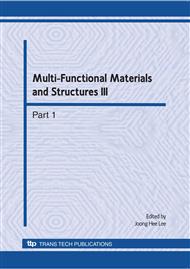p.1255
p.1259
p.1263
p.1267
p.1271
p.1275
p.1279
p.1283
p.1287
Surface Preparation Based on the Corrosion Behavior of on the Austenite Stainless Steel 304
Abstract:
Nowadays, many economist and scientist worried for sharply increased to fuel consumption. Developed and developing countries investigation new energy system. It is base on the low emission gas, high energy efficiency, permanence and cogeneration. Specially, transportation system has restricted to system’s total weight. It is concern with light weight offer to increase to performance by itself. And give to other benefit that reduce to oil consumption, improved fuel economy, engine downsizing and increased to Market-value. Fuel cell is one of the new energy systems for next generation. Normally, fuel cell is consisting of bipolar plate, MEA (Membrane Electrode Assembly) and GDL (Gas Diffusion Layer). Conventional bipolar plate material was applied Graphite. Graphite has very weak for external shock, machining process is not easy, and the main problem is that the graphite material supplied by oxidizing and reducing agent composition of the gas leak comes. Thus, by this reason, the manufacturing cost is increased. In this study, to replace the graphite material was selected as a metal material. In this experiment, STS304 austenite base stainless steel is used. This study was based on the metal material’s corrosion behavior observed with 2 type’s surface pretreatment on the STS304 with similar PEMFC operating condition. Experimental results, As-Polished condition has good corrosion resistance better than As-Received condition. It was concerned with passivation layer.
Info:
Periodical:
Pages:
1271-1274
Citation:
Online since:
August 2010
Authors:
Price:
Сopyright:
© 2010 Trans Tech Publications Ltd. All Rights Reserved
Share:
Citation:


